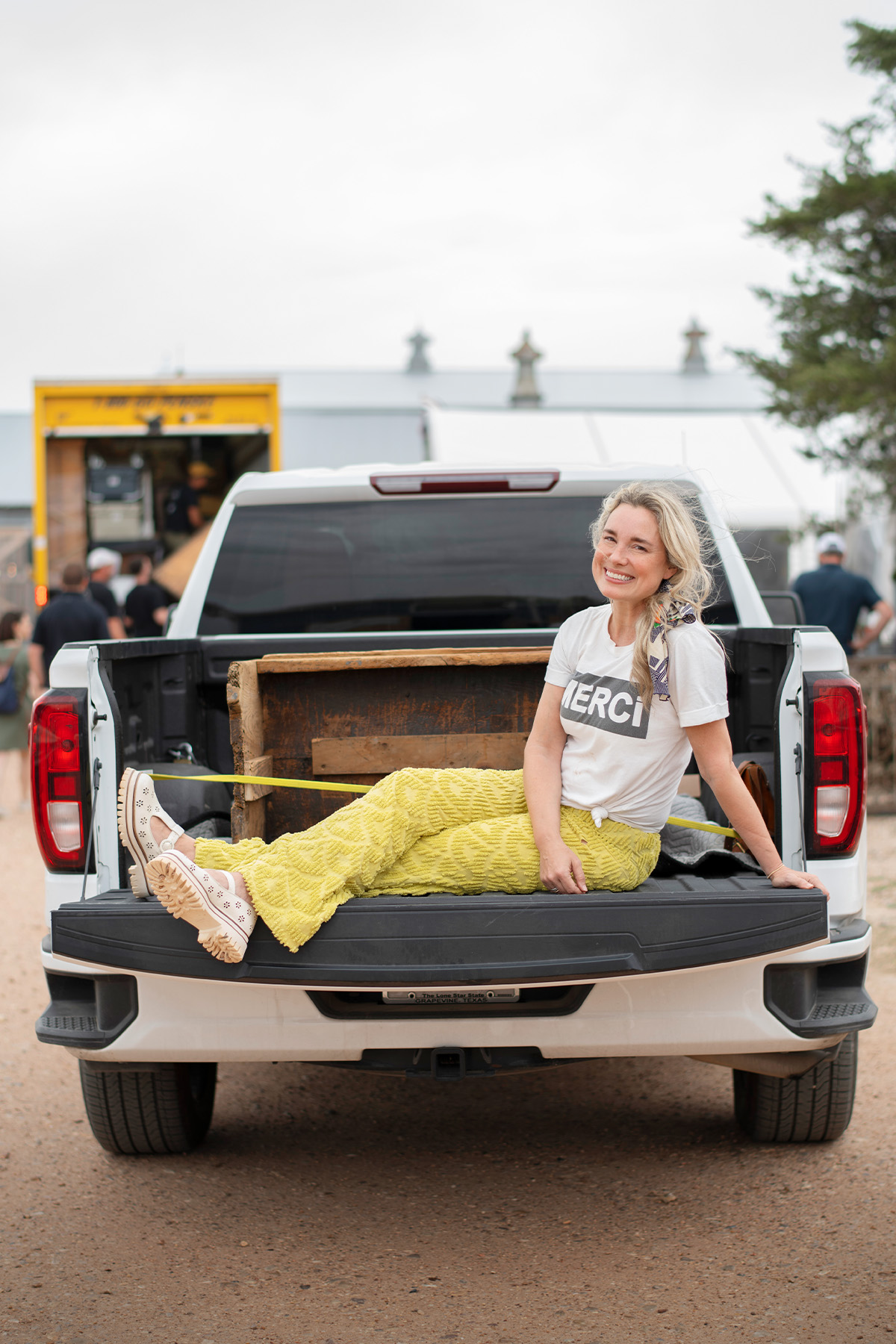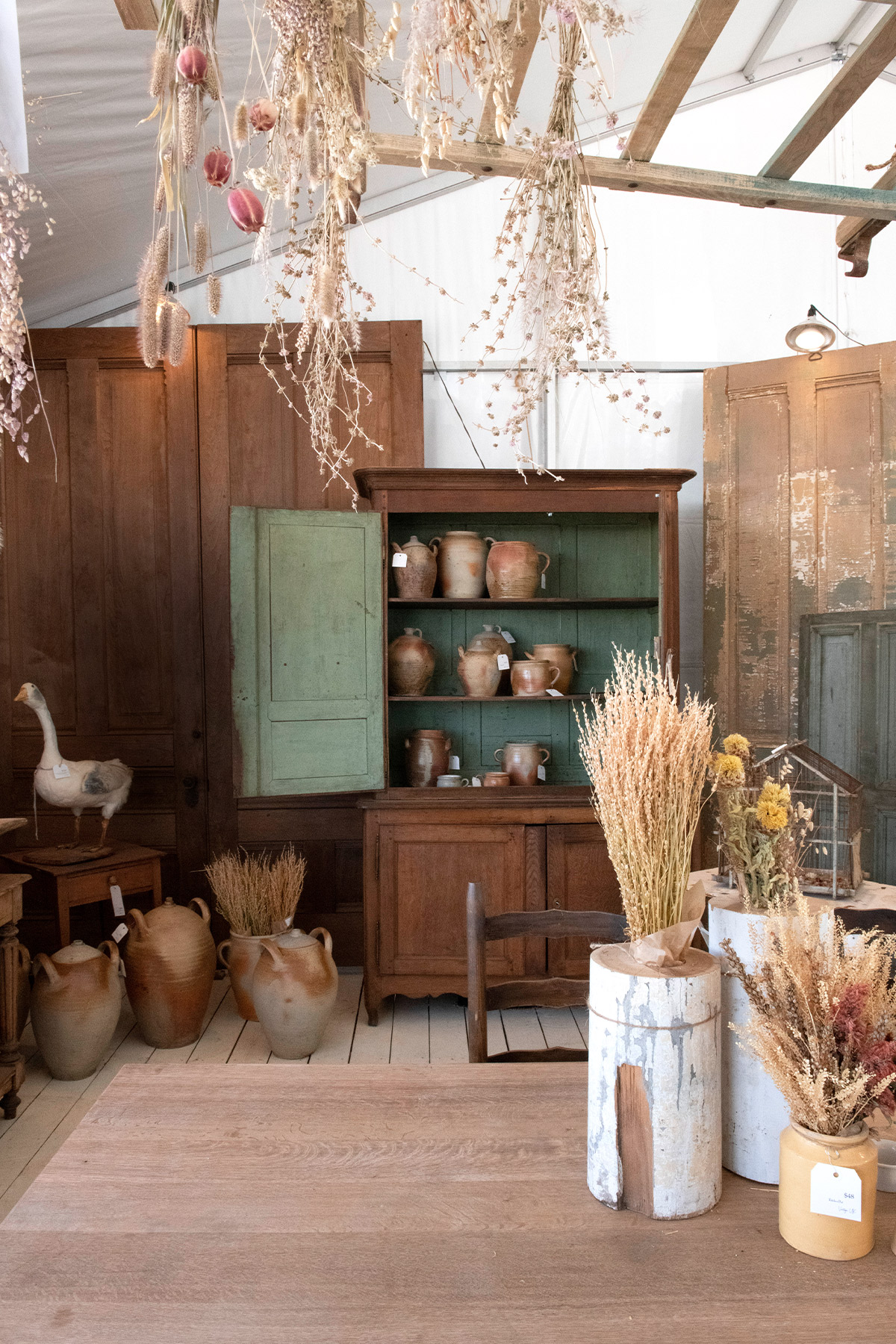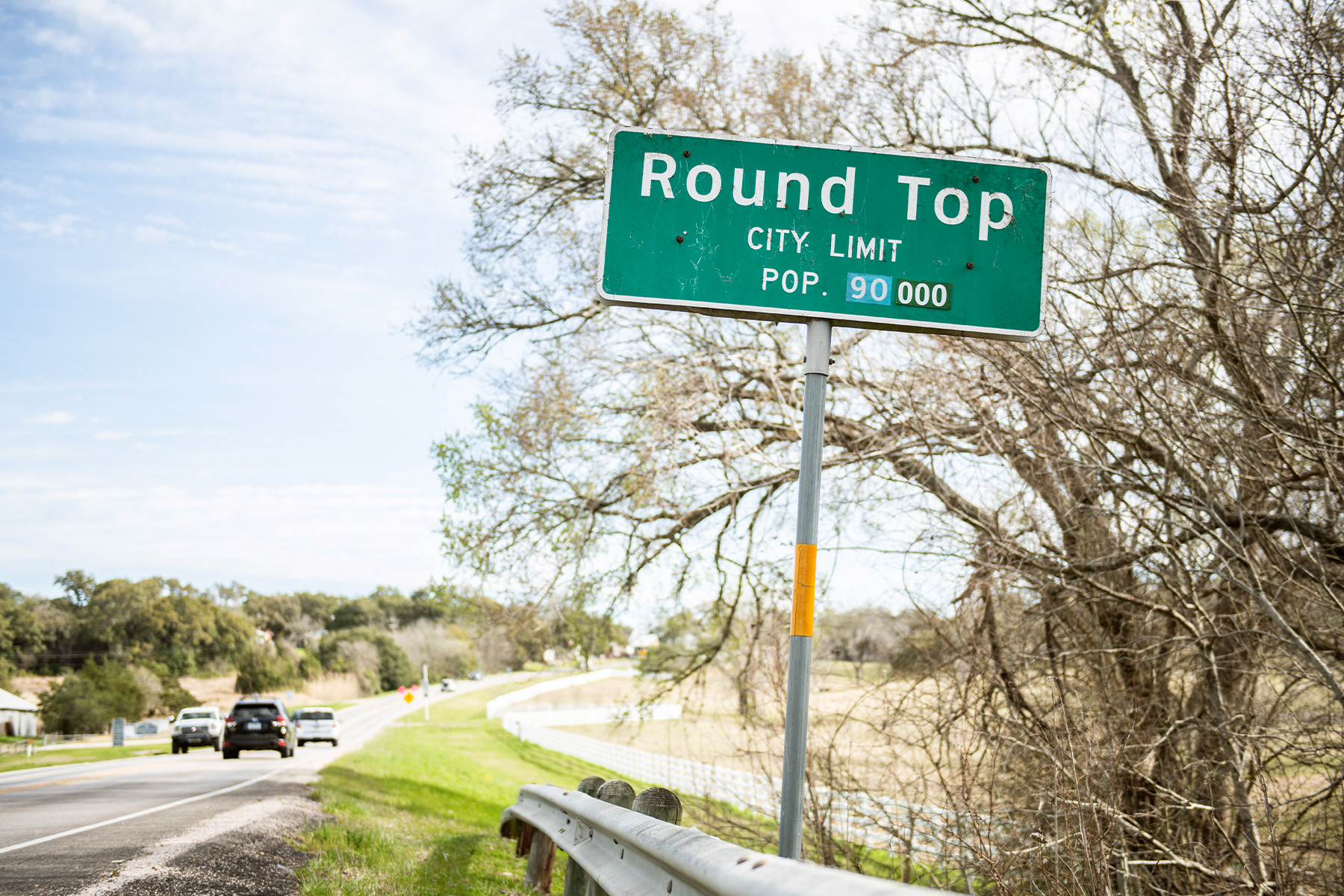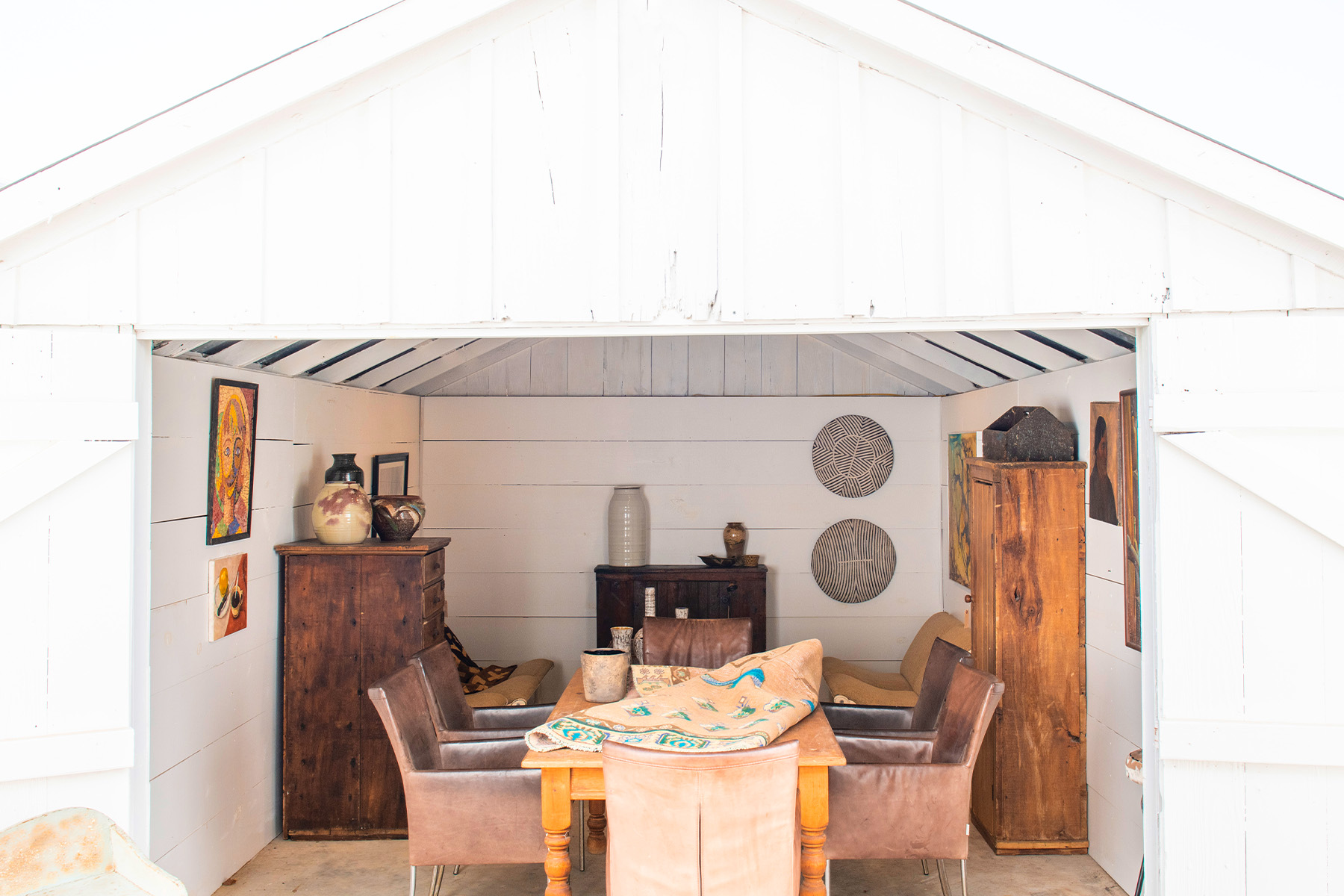The Round Top secret is out—that much we know for sure. Since it’s advent as a humble Oktoberfest in the late ’60s, the biannual antiques show has exploded into a who’s who affair with 4,000 vendors and nearly 100,000 visitors taking over the sleepy Central Texas town. But how did it become what it is today, and with big-name buyers moving in, where is it headed? With VIP shoppers swooping in and corporate backers buying up venues, what will happen to the fabric of this once-quaint antiques fair? We look at the past, present, and future of this beloved shopping event.
How It All Started
By S. Holland Murphy
When Ima Hogg entered the building, antique dealers snapped to. “Miss Ima,” grand dame of Houston society, was looking to furnish her pet restoration project, the Stagecoach Inn in Winedale. “She was a very important person—and a good buyer,” says Nancy Krause, one of 22 dealers invited in 1968 to the first Round Top Antiques Show at Rifle Hall.
In the 1960s, many well-to-do city folks were purchasing land and fixing up country homes on the Fayette County prairies. Hazel Ledbetter was first to hone in on Round Top, a town encompassing just under one square mile. It was Ledbetter who sold the Winedale property to Hogg and who would sell many of Round Top’s old pioneer houses to Faith Bybee. (Faith and Charles Bybee being the couple for whom the Dallas Museum of Art changed its curatorial policy on the decorative arts so as to acquire their collection.)
It was also Ledbetter who told antique dealer Emma Lee Turney that she ought to start a show in Round Top. And start a show she did. The event was a laid-back affair in those early days, with the first fair advertised as a German “Oktoberfest,” with a biergarten alongside antique booths. Krause recalls the scent of the smoke pits wafting through Rifle Hall’s open windows. It wasn’t until a couple years later, when Turney presented her dealers with contracts, that the crew realized the Round Top Antiques Show was no casual community event but a serious enterprise.
Round Top was drawing crowds, and venues began popping up all along Highway 237. Turney bought a patch of land five miles north of Round Top, and built the Big Red Barn, adding 30,000 square feet of antiques to her domain. The Continental Tent came next. “It became the thing to do and the place to say you bought something,” says Krause.
But perhaps Round Top’s fate as host to the nation’s largest antique show was written in the stars long before Turney and the doyennes of Houston society came along. Maybe it was a destiny manifested by the German immigrants who settled there in the 1840s and built the town’s namesake tower with its octagonal roof. The Texas town that came to be an international design destination was named after an architectural element—it almost seems too appropriate.


How It’s Going
By Coryanne Ettiene
Ten years ago, I was a newly adopted Texan on a writing assignment to interview an antique linen dealer in Round Top. I’d been to Brimfield, the vaunted flea market in rural Massachusetts, a few times before, so I knew what to expect when rolling farmland evolves into a temporary antique shopping Mecca. But that is where the similarities ended.
Beyond the bluebonnet-lined highways and down a normally tranquil road awaited a boom town of a few thousand shoppers walking through miles of tents filled with everything you never knew you needed. It was glorious to witness, and not just because the people-watching was nothing short of brilliant, but because the moment you got out of the car, you couldn’t help but soak up all the “Round Top Happy” that permeated everything, making it impossible not to get caught up in the revelry.
With scarcely a blog post to direct me, I found a slim show guide to navigate through the maze of vendors. Cash was the only currency. Royers was practically your only food option. And forget about getting a cell phone signal—when you entered Round Top, you gave up all notions of modern life in exchange for a truckload of history purchased from a dealer living the Van Life before it was trendy.
Round Top was a gem that was passed down through the generations. Only the hearty and dedicated knew where the Round Top Road turn-off was. Even Google scarcely knew of it. At the time, three hundred bucks could buy you a dresser, a few yards of vintage fabric, and a pair of tattered cement chickens to adorn your chicken coop. And you certainly never saw a selfie line at the Round Top city limits sign.
While Round Top Happy continues to captivate everyone who arrives, progress has taken hold of this small town. What was once a food desert is now a food oasis; look no further than the chef-inspired menu at Oakbones for proof. Today, even vegans can show up unburdened with the need to pack a cooler. The arrival of social media (and more reliable cell service, huzzah!) paved the way for the Round Top runway to take shape, ensuring that everyone is dressed for the occasion regardless of weather.
Local business owners are thrilled with the changes, including Nick Mosley, co-owner of Townsend Provisions. “With more people coming to town year-round, it created a demand for more shopping, food, and lodging,” he says. “The town’s growth in such a short amount of time has been remarkable.” And it’s not just daytrippers passing through; the town is hosting enough visitors from outside the Lone Star State that Paige and Smoot Hull of The Vintage Round Top transformed their modern farmhouse property into a year-round event center, complete with meeting space and a collection of tiny cottages.
Indeed, ask any small business owner in Round Top and they’ll agree: This is the golden age of Round Top that has been a long time coming.

Where to Next?
By Kendall Morgan
Round Top has evolved from an under-the-radar antique collector’s paradise to an essential stopover for top design talent. But as private dinners proliferate and celebs pop in for browsing, is this tiny town in danger of oversaturation?
Coryanne Ettiene, who for nearly a decade has had an outpost of her McKinney boutique Ettiene Market in Blue Hills, has witnessed the sea change firsthand.
“You had people who came from all over the country, but these were professional antique dealers, so they all knew each other,” she recalls. “Now Joanna Gaines comes in on her helicopter and so does Miranda Lambert. Watching it has been pretty surreal.”
Indeed, the hunt has evolved from dirty digging to finely curated displays, and the uniform of dusty boots and faded jeans has given way to wide-brimmed hats and Hunter Bell dresses.
“It’s probably trying to shed that flea market identity and going more in the direction of High Point,” says Scott Smith of SVO Antiques, who has been attending for 15 years. “If you’re holding onto warm fuzzy notions Round Top had for you when you first went with your mom, that’s probably going to go away.”
In addition to spring and fall markets, a third market in January is picking up traction as well. And though the pandemic forced a brief pause, things came roaring back by late 2021. “There were a lot of new buildings, new venues, and new places to stay—and VIP dinners,” says Dallas interior designer and seasoned Round Topper Jan Jones about her return in spring 2022.
The mix of new goods alongside antiques could also be a welcome development as the crowd that shops Round Top changes. Blue Hills in particular adheres to a “something for everyone” philosophy—from high-end European to country vintage, reproductions to clothing.
“What we’ve seen since we started operating Blue Hills is a ton of vendors who are wholesalers,” says Stephanie Layne Disney, whose family purchased the site in 2018. “It’s become this incubator for new businesses or old business trying new things.”
Bargain hunters know arriving before the show opens is key to snagging the best pieces. For some local retailers, harnessing the buying power of weekenders drawn by the town’s reputation means it makes sense to keep things going off season. Currently in the process of doubling the size of Market Hill, owner Paul Michael has opted to open every Wednesday through Sunday the past two years. Still, year-round retail in Round Top has challenges.
“It totally changes when the show’s not going on,” he says. “It’s evolving into a much higher income area, so the struggle is where workers are having to drive 30 or 40 miles.”
Pop-A-Top Bottle Shop owner and Chamber of Commerce president Tiffany Reid describes the current state of the town as a tale of two Round Tops, the disparities of which are difficult to balance. For that reason, says Reid, “We’re working really hard to make Round Top a year-round destination.”
You had people who came from all over the country, but these were professional antique dealers, so they all knew each other. Now Joanna Gaines comes in on her helicopter and so does Miranda Lambert. Watching it has been pretty surreal.
Coryanne Ettiene
Which means there’s still room for development—including a new shopping enclave in Round Top Square and luxurious new accommodations like the Red Antler Bungalows. A group of investors associated with Brook Partners—the group that operates Fashion Industry Gallery and Dallas Art Fair—have big plans for Marburger Farm, arguably the show’s most iconic site. After purchasing the Farm in 2021, the team is working on elevating food service while keeping their dealers’ standards high. The Laynes have added 40,000 square feet to Blue Hills and have just announced the family’s ownership of the Big Red Barn. They intend on preserving the Barn’s authentic American antique assortment—with the addition of better food and cocktails.
However things grow or change, residents are poised to ensure the town’s inherent charm is protected. “I don’t think the county or the town want to see us turn into a Fredericksburg,” says Red Antler co-owner John Cone. “With property values, whatever you’re building has to be really nice, or it just doesn’t make sense. That in itself is going to keep a lot of the smaller T-shirt shops and things like that from coming in.”
Jeremy Buonamici, COO of Brook Partners and now CEO of Marburger Farm, compares the destination to another Texas treasure. “I suspect Round Top will follow a similar trajectory as Marfa,” he muses. “We really do love what it is today, and so from that perspective, if it ain’t broke, don’t fix it.”










